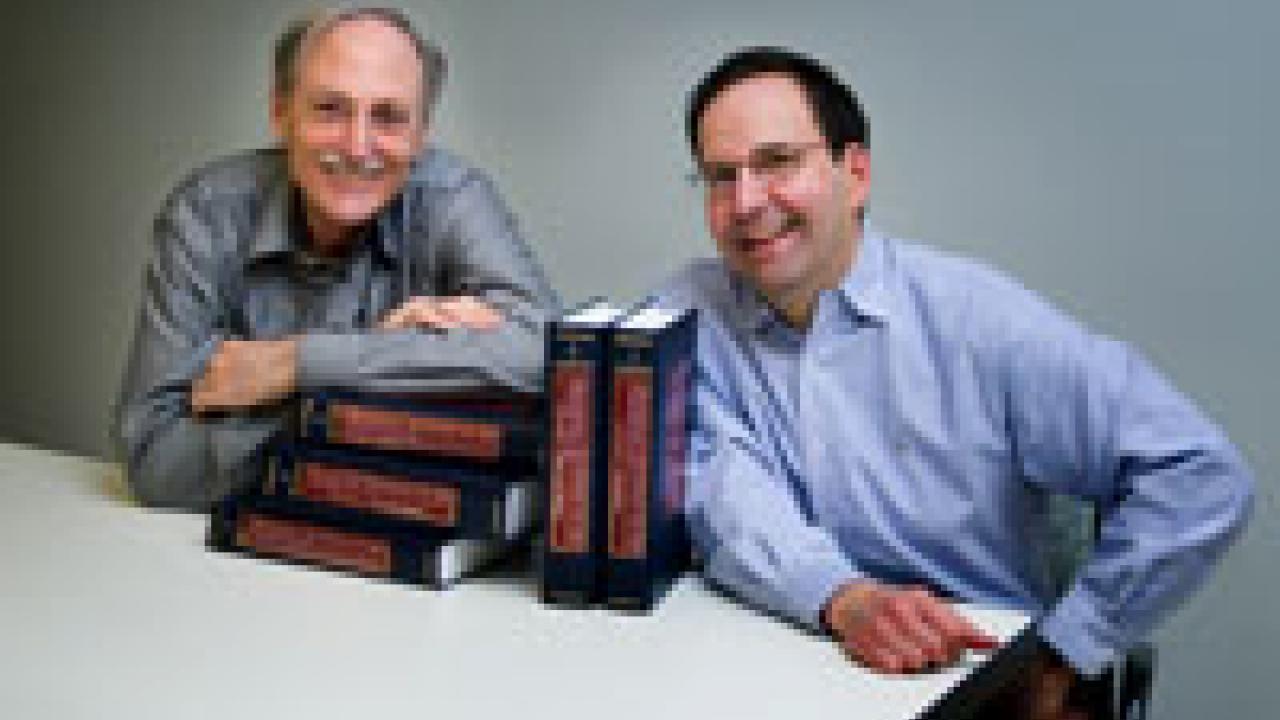A year after UC Davis professors Alan Olmstead and Scott Gartner published a book on the history of America through statistics, the laurels are flowing in.
Newsweek's economics columnist, Robert Samuelson, praised Historical Statistics of the United States (Millennial Edition), and the column was syndicated across the U.S. In his column, Samuelson wrote, "We need to remember that these numbers depict subjects that are more than idle intellectual curiosities. They define our national character and condition."
In addition, the American Library Association named the five-volume reference series an outstanding reference source. Dartmouth College gave it an honorable mention medal. And the Economic History Association devoted not one but five book reviews — one for each of the volumes.
The reference source's reputation has spread, with more than 1,000 sets of the 28.6-pound, 4,000-page, five-volume resource sold to libraries, universities and private sources across the world. And that is at $990 a set, according to Cambridge University Press' Web site.
Could the book eventually become the most popular reference book next to the Oxford English Dictionary?
"They've got a shot at it," said UC Davis humanities and social sciences reference librarian Mike Winter.
"It's the most complete statistical source on the U.S., bar none," said Gartner, a professor of political science. "It has anything you ever wanted to know about from walnut production to slaves to housing prices to energy production and Indian battles."
Olmstead and Gartner were part of a team of six editors-in-chief that originated, defined and managed the gargantuan task over 11 years. The other editors — all economic historians — were Susan Carter and Richard Sutch of UC Riverside, Gavin Wright of Stanford University and Michael Haines from Colgate University.
University played key role
By the end, they had engaged more than 80 of the nation's top scholars, scores of graduate students, three computer software teams and publishing staff on three continents to get the new series published in 2006 by Cambridge University Press.
Besides the 13 million numbers, 70-plus essays that puts the numerical information into context, more than 1,900 tables of statistics, and a wealth of footnotes and references, what makes this book special is that UC Davis can take much of the credit for starting and finishing the project.
To provide a broader view outside his field, Olmstead invited Gartner, who had just finished his doctorate in 1992. Gartner, then an assistant professor, was particularly intrigued by the idea of putting the statistical information online.
Actually, His-torical Statistics is the fourth "edition" of the reference book, the last being a two-volume, 1,200-page version published in 1976 by the U.S. Census Bureau, with substantial scholarly assistance.
The editors-in-chief started in 1993 with a project to digitize the 1976 version on a CD.
"It was a nightmare. One of the things we had to learn was that it is really hard to manipulate millions of numbers," Gartner said. "Few had put out software using as complex numerical tables as we had.
"Alan and I finished thinking, 'This is not the way to do it.'"
Advances in software have helped the new online version become especially useful, Gartner believes. It has fairly intuitive ways of searching, combining and contrasting information, and, in fact, allows users to download tables in six different formats, including Excel.
A big part of the editors' job was selecting pre-eminent American scholars "who wrote the book" on various topics. Then they invited these scholars to volunteer their knowledge — and to help seek funding from their universities and agencies for the project.
For example, Gartner, an expert on war and domestic policy, wrote the armed forces and national defense section, and supervised the veterans and politics sections.
And Olmstead contributed his scholarship on agricultural economics as an editor, writer and a leader in the field. (He will step into the presidency of the national Economic History Association in September.)
Three other UC Davis experts contributed: economist Peter Lindert, who wrote the essay on consumer prices and constructed the economic statistics to go with it, as well as agricultural and resource economists Julian Alston and Daniel Sumner.
Alston contributed his expertise on agricultural productivity while Sumner co-wrote with Olmstead the sections on agricultural programs and farm policy.
New information
To adjust for new social norms, the editors sought out scholars who dug out original sources and then reconstructed the data. For instance, hard-to-find statistics on the Confederacy are now included, and Gartner unearthed rich numerical information on Indian battles from 1866 to 1891.
"We added new chapters on gender, slavery, non-profits, outlying territories, American Indians, poverty," Olmstead said. "In the past 40 years, there has been a huge change in emphasis with a broader understanding of history."
'Godsend for reference librarians'
As someone who has nearly 40,000 reference books at his fingertips, reference librarian Winter has high praise for the book. He believes the essays especially will be very useful to the students, scholars, journalists and researchers needing to interpret the data.
"A common complaint for reference books like these is, 'You give me the numbers but you don't tell me what they mean.'"
From the early days, Winter supported Olmstead and Gartner's idea to update the Historical Statistics, especially since the data was already 20 years old when they started.
"It's a gap that has been around for ages," Winter said. "This is a godsend for reference librarians."
Information on the book, Historical Statistics (Millenial Edition) can be found on the Web, through the UC Digital Library at http://hsus.cambridge.org/HSUSWeb/HSUSEntryServlet. (You need a UC domain to gain access.)
Media Resources
Susanne Rockwell, Web and new media editor, (530) 752-2542, sgrockwell@ucdavis.edu
